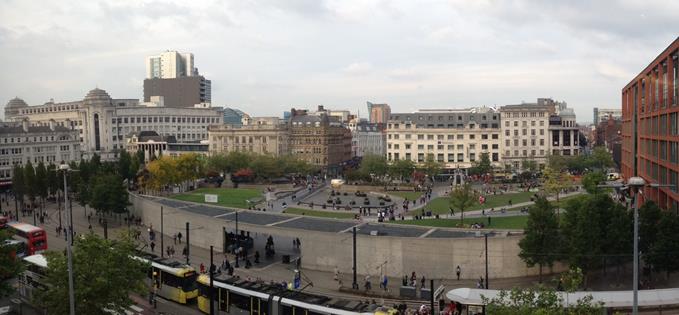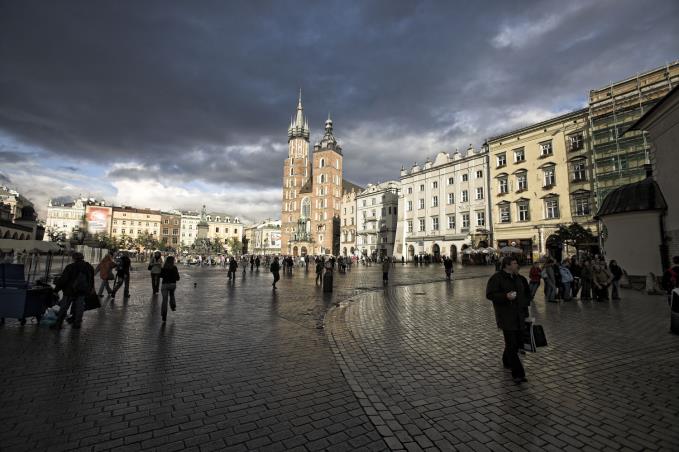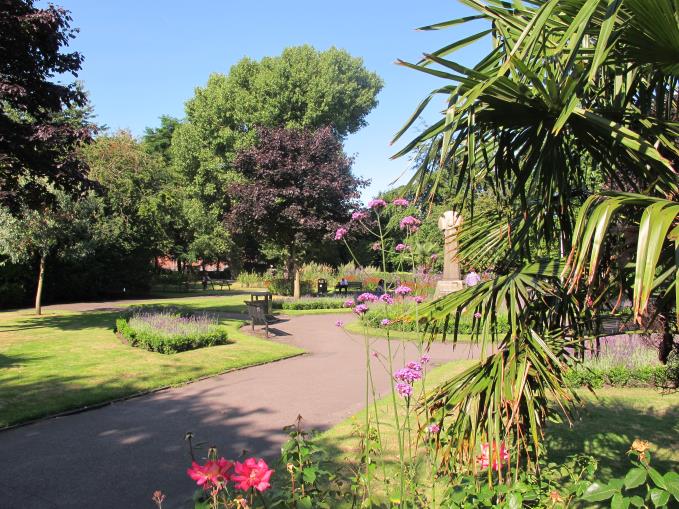CONFIDENTIAL has been critical of Piccadilly Gardens since 2007 when we published an article dismissive of everything about it. We've constantly campaigned for a change, we've had walkabouts and one to one sessions with councillors and business leaders.
It's strange that as a city we always feel tempted to clutter our open spaces
But the change we've argued for is the exact opposite of what the MEN are presently calling for. They've even launched a petition.
What the MEN are calling for is a return to the past. As usual when it comes to city centre planning they've been snorting the cocaine of nostagia. They are high on turning the clock back and restoring the Gardens' sunken glory.
Nostalgia is one-eyed, forgetting the rainy days and only recalling the sunshine. Up until the present re-envisioning for the Commonwealth Games in 2002 the former sunken gardens were shorthand for trouble, a dilapidated space populated by the White Lightning and Special Brew tribes.
Back in Rochdale in the late seventies, as a child, I remember dark tales from older brothers' friends of the Gardens' grim nature, especially in the evening. The 1950s glory days of beautifully kept flower beds and lawns were already becoming a distant memory as council funds began to leech from parks and gardens budgets. The sunken gardens had sunk beyond redemption.
 Cluttered past: Piccadilly flowers in the sixties at their best, or gaudiest
Cluttered past: Piccadilly flowers in the sixties at their best, or gaudiest  Cluttered present: How many more obstacles and things could they put in Piccadilly Gardens?
Cluttered present: How many more obstacles and things could they put in Piccadilly Gardens? A city's shame
A city's shame Very pleasant space after a busy weekend
Very pleasant space after a busy weekend The prospect of redigging them and putting them back would be impractical and an obsolete gesture. It would again display Manchester's lack of awareness of what good city centre public spaces are about. The city's squares should give us chance to catch our breath. At present Exchange Square does this fairly well despite the ankle-breakingly needless and usually broken water feature.
It's strange that as a city we always feel tempted to clutter our open spaces.
St Ann's Square is good but has that sad, dribbling cotton flower fountain, the intrusion of an electricity substation and a lot of needless concrete balls. Stevenson Square is split into two with confusing road-lanes, bus stops and another electricity substation.
The revamped St Peter's Square will look superb when finished but has been part-sacrificed on the altar of infrastructure expediency and over-filled with tramlines. The Great Northern Square has a daft sunken 'theatre-space' which remains unused.
Albert Square is the best of the city squares with its perimeter of trees and unimpeded space before the Town Hall gates.
As for Piccadilly Gardens, they are a city shame. Do our knightly establishment of the Council Leader, Sir Richard Leese, and the chief executive, Sir Howard Bernstein, avert their eyes when they pass through? Do they just avoid the area? Here be dragons and all that.
Piccadilly Gardens has undreamable amounts of clutter with idiotic raised planting isolating the nineteenth century statues, the clumsiest non-fountain imaginable, lawns that hate the notion of grass and a massive concrete wall presenting its backside to trams and buses. Oh dear. The result is Piccadilly Gardens has been made into an obstacle course when it's the only main provincial British square capable of real scale.
Part of the problem is the name.
If we called it 'a square' and simply had done with it then the sentiment over the 'gardens' would disappear with a gentle 'pooft' like a child's bath bubble blown on a summer's day.
What Confidential has argued for consistently is that Piccadilly Square should be hard-surfaced north to south, from the Oldham Road end to the former Piccadilly Plaza buildings with that silly concrete wall removed. This would instantly create a grand civic space that would be the envy of other British cities, a space with power, gravitas and very few places for drug-dealers to hide behind (they were an excellent idea those tall planters weren't they?).
Toss a few other European cities we admire up into the air and you'll land on one with just such a grand open square. But let's not go for Place de la Concorde or Red Square and so on in capital cities, let's choose places in similar sized centres. Three such squares I admire are Piazza de Plebiscito in Naples, Main Square in Cracow and the Place Bellecour in Lyons. Look at them below.
 Piazza del Plebiscito, Naples - magnificent open space, quiet during the heat of the day, packed in the evening
Piazza del Plebiscito, Naples - magnificent open space, quiet during the heat of the day, packed in the evening Cracow, the main square
Cracow, the main square Place Bellecour, Lyon
Place Bellecour, Lyon Place Bellacour again
Place Bellacour again Place Bellecour is perhaps the best example of how grand a wide-open space looks, a foil to the old statues and a blank canvas for events. With the Place Bellecour example we could even retain the present trees but get rid of everything else and add appropriate benches. And the good thing about this idea is it would make us look modern and contemporary and be much cheaper than the MEN's collapse into the past.
It's cruelly amusing that the last change in Piccadilly Gardens ignored Manchester's own advice to itself in the 1990s.
Back then Hulme was being re-developed and one of the great unsung heroes of British post-war planning was written by a team of professionals, residents and amateurs led by architect George Mills, called Rebuilding the City, Guide to Development, Hulme, Manchester. You can read this excellent document here.
The guide deals with a suburban situation but many of its principles could be applied to city centres. One of its sub-headings is 'Definition of Space'.
With sixties' redevelopments where a street ended and where a street began - the building line - often became blurred. The grassed areas of Piccadilly Gardens ignore the common sense in the Hulme Guide to Development, especially with the 'definition of space'.
Applying the Hulme principles Manchester's squares would be real squares, hard-surfaced, clutter-free, ready for events. Meanwhile proper city centre gardens - Sackville, Parsonage, St John's, Cathedral Gardens and much of the Castlefield area - could re-assert themselves. Maybe they could even have their maintenance budgets enhanced so they were managed to the highest European standards. Despite what people think there is lots of greenery in the city centre.
 St John's Gardens is a proper gardens, not a square, and when well maintained very lovely. We need to give up the notion of Piccadilly Gardens as a anything but a square
St John's Gardens is a proper gardens, not a square, and when well maintained very lovely. We need to give up the notion of Piccadilly Gardens as a anything but a square
Suddenly the city centre would make more sense. It's spaces would be defined and Manchester's squares would give us a chance to catch our breath, not make us trip over obstacles.
Back in 1917 Harold Brighouse wrote Hobson’s Choice and in it wrote this. ‘In Manchester, at the present day, the finest city site is derelict, an eyesore and a byword. Some years ago the town infirmary was there but the building had become too small and a huge new place was built, leaving the most central site in all the city to become the King Charles’s Head of Council debates, some wanting an open space, others a municipal Cotton Exchange, others an Art Gallery. Meanwhile the grass grows in Piccadilly and periodic visitors are left to wonder where the Manchester man’s reputation for business comes in.’
The sunken gardens were a compromise and a stop-gap. At present Piccadilly Gardens is an oxymoron, a misnomer, a mangled mishmash of historical error compounded and continued by a sentimental attachment to an unintended hundred year old mistake. A conversation that's been going on for four generations is a conversation too long.
Let's have a Place Bellecour, not a half-hearted backwards glance.
Follow @JonathSchofield








 1955 glamour in the sunken gardens - from Andrew Simpson's
1955 glamour in the sunken gardens - from Andrew Simpson's 





